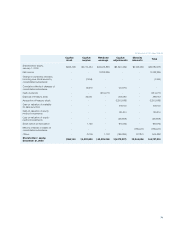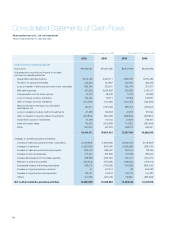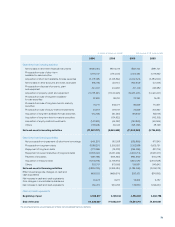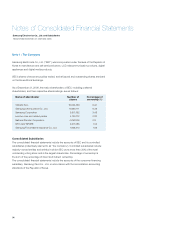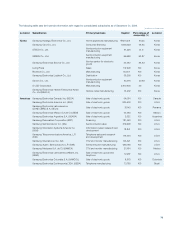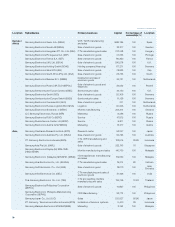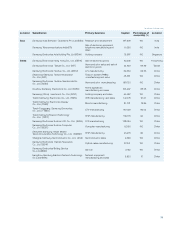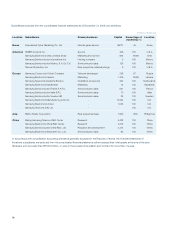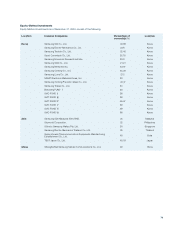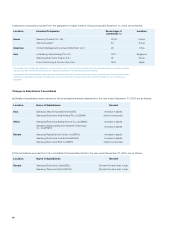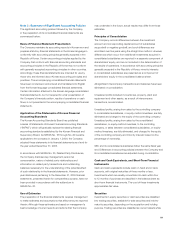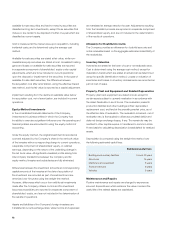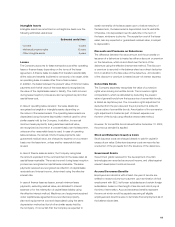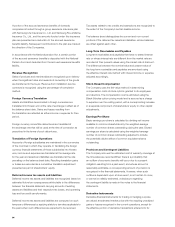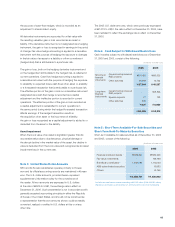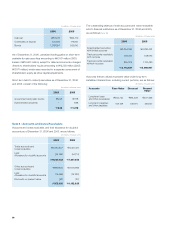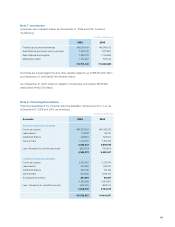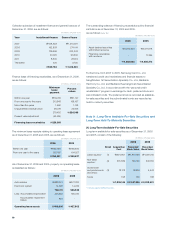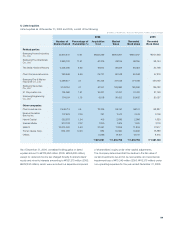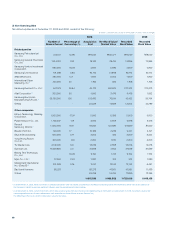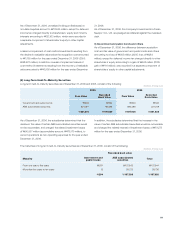Samsung 2006 Annual Report Download - page 91
Download and view the complete annual report
Please find page 91 of the 2006 Samsung annual report below. You can navigate through the pages in the report by either clicking on the pages listed below, or by using the keyword search tool below to find specific information within the annual report.81
Note 2 : Summary of Significant Accounting Policies
The significant accounting policies followed by the Company
in the preparation of its consolidated financial statements are
summarized below:
Basis of Financial Statement Presentation
The Company maintains its accounting records in Korean won and
prepares statutory financial statements in the Korean language in
conformity with accounting principles generally accepted in the
Republic of Korea. Certain accounting principles applied by the
Company that conform with financial accounting standards and
accounting principles in the Republic of Korea may not conform
with generally accepted accounting principles in other countries.
Accordingly, these financial statements are intended for use by
those who are informed about Korean accounting principles and
practices. The accompanying consolidated financial statements
have been condensed, restructured and translated into English
from the Korean language consolidated financial statements.
Certain information attached to the Korean language consolidated
financial statements, but not required for a fair presentation of
the Company’s financial position, results of operations or cash
flows, is not presented in the accompanying consolidated financial
statements.
Application of the Statements of Korean Financial
Accounting Standards
The Korean Accounting Standards Board has published
a series of Statements of Korean Financial Accounting Standards
(“SKFAS”), which will gradually replace the existing financial
accounting standards established by the Korean Financial and
Supervisory Board. As SKFAS No. 18 through No. 20 became
applicable to the company in January 1, 2006, the Company
adopted these statements in its financial statements as of and for
the year ended December 31, 2006.
In accordance with SKFAS No. 20, Related Party Disclosures,
the Company discloses key management personnel
compensation, nature of related party relationships and
information on related party transactions and outstanding
balances necessary for the understanding of the potential effect
of such relationship in the financial statements. However, prior
year disclosures pertaining to the December 31, 2005 financial
statements, presented herein for comparative purposes, have not
been provided in accordance with the addendum to
SKFAS No. 20.
Use of Estimates
The preparation of the financial statements requires management
to make estimates and assumptions that affect amounts reported
therein. Although these estimates are based on management’s
best knowledge of current events and actions that the Company
may undertake in the future, actual results may differ from those
estimates.
Principles of Consolidation
The Company records differences between the investment
account and corresponding capital account of subsidiaries
as goodwill or negative goodwill, and such differences are
amortized over five years using the straight-line method. However,
differences which occur from additional investments acquired in
consolidated subsidiaries are reported in a separate component of
shareholders’ equity, and are not included in the determination of
the results of operations. In accordance with accounting principles
generally accepted in the Republic of Korea, minority interests
in consolidated subsidiaries are presented as a component of
shareholders’ equity in the consolidated balance sheet.
All significant intercompany transactions and balances have been
eliminated on consolidation.
Unrealized profits included in inventories, property, plant and
equipment and other assets, as a result of intercompany
transactions, are eliminated.
Unrealized profits, arising from sales by the controlling company
to consolidated subsidiaries, or equity-method investees, are fully
eliminated and charged to the equity of the controlling company.
Unrealized profits, arising from sales by the consolidated
subsidiaries, or equity-method investees, to the controlling
company, or sales between consolidated subsidiaries, or equity-
method investees, are fully eliminated, and charged to the equity
of the controlling company and minority interest, based on the
percentage of ownership.
SEC and its consolidated subsidiaries follow the same fiscal year
end. Differences in accounting policies between the Company and
its consolidated subsidiaries are adjusted during consolidation.
Cash and Cash Equivalents, and Short-Term Financial
Instruments
Cash and cash equivalents include cash on hand and in bank
accounts, with original maturities of three months or less.
Investments which are readily convertible into cash within four
to 12 months of purchase are classified in the balance sheet as
short-term financial instruments. The cost of these investments
approximates fair value.
Securities
Investments in equity securities or debt securities are classified
into trading securities, available-for-sale securities and held-to-
maturity securities, depending on the acquisition and holding
purpose. Trading securities are classified as current assets while


